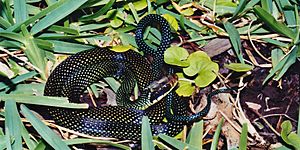Speckled racer facts for kids
Quick facts for kids Speckled racer |
|
|---|---|
 |
|
| Drymobius margaritiferus, Tamaulipas, Mexico | |
| Scientific classification | |
| Genus: |
Drymobius
|
| Species: |
margaritiferus
|
| Synonyms | |
|
|
The Drymobius margaritiferus, often called the speckled racer, is a harmless snake that lives in the Americas. It belongs to a group of snakes called colubrids. Its scientific name, margaritiferus, means "pearl-bearing" in Latin. This name comes from the pearl-like spots you can see on its scales.
Contents
Where Does It Live?
This snake lives across Central America. You can find it from Mexico all the way down to Panama and parts of northwest Colombia. It lives in places from sea level up to about 4,750 feet (1,453 meters) high.
In Mexico, it lives along the coasts and lower mountain slopes. It goes up the west coast to Sonora and up the east coast to northern Tamaulipas. The speckled racer also barely reaches into the very southern part of Texas, USA. Here, it is quite rare to find.
These snakes can live in many different places. They like forests, forest edges, and open areas. You might also find them in grasslands, marshlands, and even near roads. People often say they prefer wet areas with water nearby. However, they have also been found in dry forests where water is not obvious. In Costa Rica, they are found almost everywhere except the very wettest lowland and mountain areas.
What Does It Look Like?
The speckled racer is usually black. It has special yellow and blue spots on each scale. These spots make the snake look a bit greenish overall. The scales around its mouth are yellow with black lines. Its belly is usually yellow or green.
These snakes are typically about 30 to 40 inches (76 to 102 cm) long. The longest one ever recorded was 50 inches (127 cm) long!
The scales on its back are slightly ridged in the middle. The scales on its sides are smooth. There are usually 17 rows of scales around its body. The large scales on its belly (ventrals) range from 142 to 168. The scales under its tail (subcaudals) range from 85 to 126.
How It Behaves
As its name "racer" suggests, this snake is very fast and quick. It is active mostly during the day. This snake can be a bit shy. If it feels caught or handled, it might bite to defend itself.
Sometimes, when caught, these snakes might pretend to be dead. This behavior is called thanatosis. It's a way for them to try and escape danger.
What It Eats
Speckled racers eat many different kinds of food. But they mostly like to eat frogs and toads. One study looked at what was in the stomachs of 36 snakes. It found that 86% of them had eaten frogs. They also ate lizards, reptile eggs, and even small mammals. Young speckled racers are known to eat insects.
Reproduction and Life Cycle
Speckled racers lay eggs. This means they are oviparous. They usually lay their eggs in the spring. In warmer southern areas, they might lay eggs as early as February or March.
A female snake usually lays between two and eight eggs at a time. Each egg is about 1.5 inches (3.8 cm) long. The eggs typically hatch after eight to nine weeks. When they hatch, the baby snakes are about six to ten and a half inches (15.2 to 27.6 cm) long.
Different Kinds of Speckled Racers
There are four known types, or subspecies, of D. margaritiferus:
- Drymobius m. margaritiferus: This type is found from Texas to Colombia.
- Drymobius m. fistulosus: This one lives on the Pacific side of Mexico.
- Drymobius m. occidentalis: Found on the Pacific side from eastern Mexico to El Salvador.
- Drymobius m. maydis: This type lives only on the Corn Islands in Nicaragua.
Keeping Them Safe
The speckled racer is considered a threatened species in the state of Texas, USA. It is not common there. However, in many parts of Mexico and Central America, it is still a common snake. Efforts are made to protect its habitats where it is rare.
Want to Learn More?
 In Spanish: Culebra corredora de petatillos para niños
In Spanish: Culebra corredora de petatillos para niños


